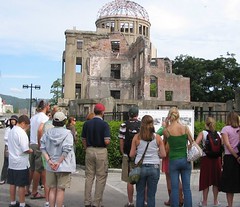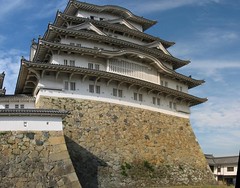September 15, 2006
Following Miyajima, we spend the night in nearby Hiroshima. Our dinner is a traditional Japanese meal where we eat many unidentifiable things - some raw, some cooked. Our hotel is very much a Western style hotel, meaning Western toilets vs. Japanese toilets, real beds, and a breakfast with the option of eggs and sausage along with sardines and litchi nuts. The bed’s headboard serves as a control panel for the room with a built-in radio and dials to control reading lamps, the ceiling lights, and a nightlight.
The top sports stories on the TV news are sumo, synchronized swimming, and the return to action of Matsui, a Japanese player for the NY Yankees.
In the morning, we begin our day of sight-thinking at the A-Bomb Dome, the preserved remains of a building where the bomb exploded. Looking around now, we see a bustling city with tall buildings, crowded streets, parks with mature trees - normal urban stuff. Seeing this shell of a building makes clear the power of the bomb and the physical devastation.
The nearby museum makes clear the graphic evidence of human suffering. Throughout, the focus is on the remaining nuclear threat and its elimination. Each time a country tests a nuclear device, Hiroshima’s mayor sends a telegram to that nation’s leader reminding them of the events of Hiroshima and asking for elimination of nuclear weapons. The most recent telegram went to George W. Bush in August 2006, after an underground test in Nevada. Such telegrams cover two walls of the museum.
Grade school groups are out in force, studying the displays and writing answers to questions for school assignments. As we leave the museum, we are engulfed by a group of Japanese students who take an opportunity to practice their English. Their greeting, “Hello. Good morning.” We answer, “Hello. Good morning.” They giggle and reply, “Hello. Good morning” and so on. In many ways, it was an unsettling, very good morning.
We stop at Himeji Castle on our return trip to Kobe, another UNESCO World Heritage Site. After walking 20 minutes to the main gate, then 10 minutes to the tower, then climbing 300 wooden steps to the top, our reward is a panoramic view to the sea. But I am most impressed with the massive stone foundations - all of which taper in from a wide base. Some curve gracefully, others are straight. Some are rubble, some cut stone. All are beautifully crafted, functional, and survive from their construction in the 17th century. In summary, I took a lot of pictures of Japanese rocks here.
Now we can say we’ve visited Bemidji and Himeji, Indianapolis and Minneapolis. How many rhyming places have you visited?
Yours in poetic geography,
Kelly


I've been thinking about your rhyming cities question, off and on, for the last day or so. What rhyming cities have I been to?
ReplyDeleteSadly, the best I can come up with is Ellettsville and Crawfordsville.